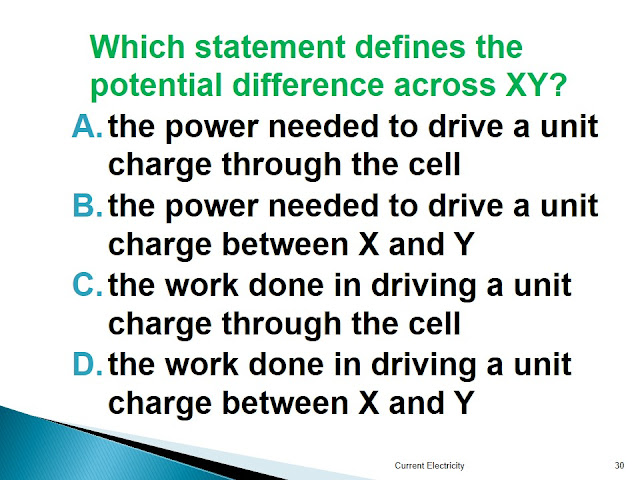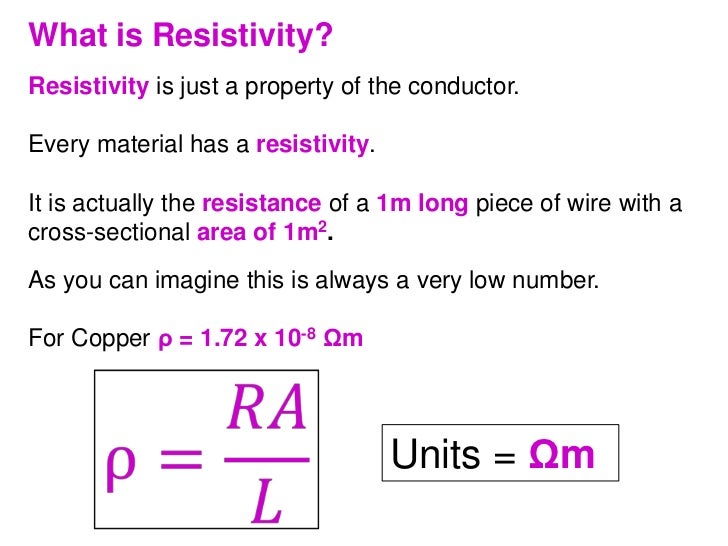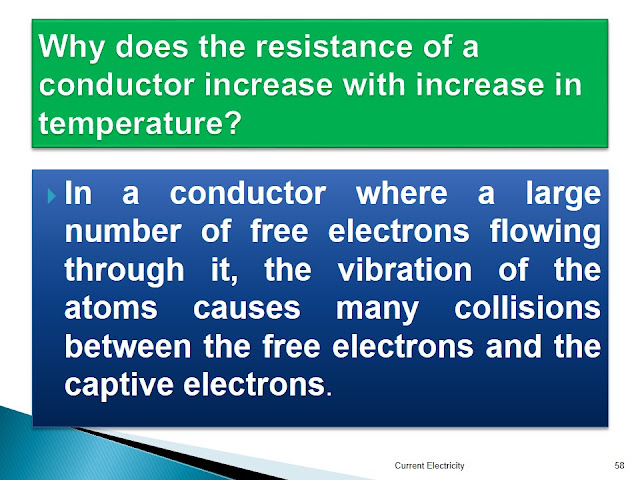Define one coulomb
The coulomb is that charge passing a point in a circuit when there is a current of one ampere for one second.
Q=It
Q6)
POTENTIAL DIFFERENCE
It is the electric potential enrgy transferred when 1C of charge is moved between the two points
Potential difference = energy transferred(w) / Charge( Q)
Q7)The potential difference (p.d) across a filament lamp is (230 V). A charge of (31 C) flows through the lamp at a time interval of (60 S). What is the energy transferred by
the lamp?
a)13.4 × 10–2 J b) 1.19 × 102J
c)7.13 × 103J d) 4.28 × 105J
Q8) What is the definition of an electric current in an electrical circuit?
a)The flow rate of positive ions.
b)The flow rate of free electrons.
c)The flow rate of free positive charges.
d)The flow rate of both positive and negative particles.
Q9) Which of the following is equivalent to the potential difference (10 V)?
a)10 J/C b)10 C/S
c)10 A/Watt d)10 F/J
Q10)The opposite graph represents the resistance (R) of a conductor against the inverse of its cross section area ( 1/A).
Which of the following statements explains the graph?
a)A large current is flowing through a thin wire.
b)A large current is flowing through a thick wire.
c)The resistance of a wire is inversely proportional to (1/A) .
d)The resistance is directly proportional to the cross section area of a wire.
http://www.physicsclassroom.com/class/circuits/Lesson-1/Electric-Potential
Q12
OHMS LAW
Current flowing through a component is directly proportional to the potential difference across it, if, temperature remains constant.
V=IR
where R=Resistance R=V/I

Q13) The voltage current characteristics of a metal wire at two temperatures θ1 and θ2 are shown below.
a)Calculate the resistance of the wire at each temperature.
b) Is θ1 or θ2 greater? Why?
RESISTIVITY
DEFINITION-RESISTIVITY
It is defined as numerically equal to the resisance of a sample of material of unit length and unit crosssectional area.
ELECTRIC POWER (P)
POWER OF A DEVICE IS THE RATE AT WHICH IT TRANSFERS ENERGY
POWER = ENERGY TRANSFERRED /TIME
P= W/t
UNIT IS WATTS (W)
1 WATT= IJOULE/SECOND 1W=1J/S
P= W/t
QUESTIONS
1.WHAT IS THE POWER OF A MICROWAVE OWEN THAT TAKES A CURRENT OF 7.5A FROM A 230V SUPPLY?
2.A SMALL 48 W ELETRIC HEATER IS CONNECTED TO A 12V SUPPLY.WHAT CURRENT PASSES THROUGH IT?
3.THE RESISTANCE OF THE CABLES LINKING THE GENERATOR TO A HOUSE IS 0.1 OHM.HOW MUCH POWER IS WASTED AS HEAT IN THE CABLES WHEN THE CURRENT IS 20A ?
CONVENTIONAL CURRENT FLOW
2014-15 Past Papers
1.The potential difference across a filament lamp is 230V. a charge of 31C flows through it in 60s.What is the energy transferred by the lamp?
2.A wire of radius 0.15mm has a resistance of 6.23ohms and a length of 20 cm.What is the resistivity of the wire when the length is doubled?
3. The diagram opposite shows an electrical circuit.
a. Indicate with an arrow on the circuit the direction of flow of electrons. [1 mark]
b. Calculate the charge flow through the filament lamp over a time period of (300 s). [2 marks]
2012-134)A lamp 60W and 120V was turned on for 10 hours.How many coulombs of charge passed through it?
5)a)what is meant by saying that the electrical current equals 5A?
b) A wire carries a steady current of 2A. How many electrons pass through the wire in 2 seconds?
6) A light bulb is marked 60W and 120V.Find out a) current flowing through the bulb b) the bulb's resistance.
7)Draw a graph showing the variation of a)resistance of a metal with temperature
b) resistivity of a metal with temperature.
8)

































































No comments:
Post a Comment